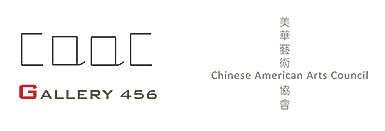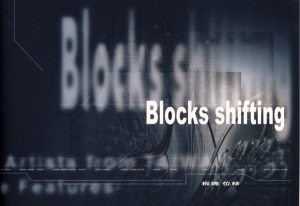藝術家: |
策展人: 楊識宏 |
地點: 456藝廊 |
Blocks shifting
The development of Taiwan's modern art evolved in conjunction with the economic prosperity of the 80's, and the gradual trend and implementation of democratic ideology of the 90's; within this brief span of twenty years, tremendous changes occurred. The pace and achievement of the development during these past twenty years, however, are even more significant than the total output of the period from 1940 to 1980. The "Pluralism" or "Multiculturalism" of cultural discourse also became the trendy topic of the academic world. Consequently, each branch contends, hundreds of flowers are in full bloom, forming a kaleidoscopic world of theories and approaches.
From the end of the 20th century to the beginning of the new millennium, the "new technology" produced through cutting edge research and development in advanced Western countries has far surpassed the influence of the Industrial Revolution of the 18th century. Today, advances made in electronics, computers, digital technology, biotechnology, nanotechnology, and others have already changed the way of thinking, the values, the ideologies, even the lifestyles of modern men. The advent of the information superhighway has already created an environment that is global - "a global village;" this is also an irrevocable truth. In this time and space, Western cultural blocks, which are mainly focused on Europe and North America, are already showing signs of loosening at the joints and shifting paradigms. These recent years have seen the discrepant relationship between the so-called "center" and the margins that have gradually extended "Decentralization;" the age of Western cultural supremacy is already eroding. The political security and economic prosperity of each nation have become woven together into an intricate network; any slight movement may disturb the unity. Now, regardless of race, religion, cultural background, history, and tradition, all of humanity embodies a complete life. When small blocks of present cultures are placed together to form larger blocks, the so-called boundaries between Eastern and Western cultural blocks, in turn, become smaller and smaller. These independent small blocks are like similarly shaped "puzzle pieces." During the process of putting them together, it is very easy to produce illusory images that are improperly placed or transferred; the similarity of each piece, however, exceeds its differences. The difference emphasized by modernism or the originality it espouses is being questioned by postmodernism. Consequently, what was once a challenging and avant-garde approach has since become doctrinal nonsense. Artistic works have become extensions and products of cultural structures; they have also gradually become "the cultural readymade" of the post-capitalistic society. This situation is a worrisome one for most people.
Although the advancement of modern art in Taiwan progressed in leaps and bounds (most Asian countries display similar modes), it appears, on the surface, to be synchronized with the world, but in reality, in a deeper structural sense, it is in fact a form of cultural colonialism - forced or voluntary assimilation. The struggle to establish subjectivity and local identity in the East or in a country like Taiwan is in a way like being coaxed into a reversed seduction, or, worse, rape by Western culture. This is an issue that holds very broad implications, many of which are not included within the scope of this study's discourse. The past situation, however, wherein larger blocks swallow smaller components, or where the strong survives and the weak are eliminated, is a cruel reality that is difficult to change - it is a form of "evolution" of culture. Today, because of globalization, the situation has already shown some improvements; small blocks already have adequate independent qualifications to present fairer situations. In turn, the small blocks have become an important element of a comprehensive whole; from ideology to actual practice, this growth process has also evolved from awakening to entering actual realistic situations. This was almost an impossibility during the first half of the 20th century. From this viewpoint of discussion and observation, this type of strategy employed by non-Western cultures is very much like the "playing off one power against the other" strategy used during the end of the Ching Dynasty or like the scheme of "attaching someone by exploiting his weakness" used since antiquity. If we do have such a consensus and examine truth through actual practice, we may see a more intriguing future for Eastern culture.
Painting is a historically old medium. After Duchamp, the medium was belittled and it aroused controversy; however, it remained strong enough to continue existing. Today, to announce that painting is already dead is a backward and foolish thing to say. If one were to say that "handwriting" or "handmade crafts" were dead because of the existence of computers and other related technologies, it would turn out to be an absurd overstatement! The more advanced technology becomes, the more valuable handmade objects become. Notwithstanding the fact that some people consider painting the mother of art, man has used images, shapes, colors, and drawings as media of communication and expressions of self; it has been this way since the Stone Age and this phenomenon is utterly irreplaceable. The changes in the different schools of painting may be very complicated, but ultimately, the original point and motivation are never lost. From examples of installation art, performance art, conceptual art, and video art of the last century, one can see it is merely changes in the media and methods; the underlying principle or artistic reality of the search for the essence of human existence remains the same. Nothing is new; what has already happened will happen again. Once some material, medium or method becomes "mainstream," non-mainstream conversely becomes avant-garde. This is because a concise definition of "avant-garde" is "anti-mainstream." Of course, avant-garde is not the only standard measurement for artistic value and quality, but it is the driving force behind the advancement of the matter. The opposing and dialectical relationship between mainstream and non-mainstream is a major rule of historical evolution. In this new millennium, many of the world's major museums, art publications, and art theorists have once more looked into, reevaluated, and discussed the issue of painting. Part of the iceberg is now visible; future developments are widely anticipated.
With the above knowledge, this exhibit that I have put together particularly emphasizes the premise of painting expression. The works of these six artists can be considered as an independent block sampling of the painting medium. The different styles and scopes of work are also a testimony to the development of modern Taiwanese art during the last twenty years. Perhaps they may not be able to represent the overall face of modern Taiwanese art, but from the combination of these individual building blocks, one can see into the realm of abstract art. The chronological age of these artists span through three generations: young, middle-aged, and old; this is also a glance into a historical depth of field. Initially, the selection of blocks from similarly shaped aesthetics was a very difficult task to begin with. It is inevitable, then, that any selected combination would not be comprehensive enough. Furthermore, exhibition space was very limited; it was not possible to include more works of many other outstanding artists. This was our greatest regret. The combination selected was not meant to highlight any form of artistic idea; there are no philosophical links between them. They are not a collective nor are they a single representation. Rather, the independently autonomous small blocks fulfill larger cultural imperatives as well as its spiritual outlook.
Li Shi-Chi is the oldest member of the group. In Taiwan's art circle, the quality and quantity of his works are among one of the most consistent. He uses diverse media, including printmaking, sculptures, water and ink paintings, and lacquer paintings. His style is daring and innovative, yet maintains his principles, never becoming superficial or pretentious; he is a model artist worthy of being emulated. Huang Ming-Che belongs to the post-war generation. In the early works, he started out with realism, inhabiting a strong drawing background, and, later, he found himself leaning more towards abstraction. His control of color and lines as well as other painting elements is outstanding and unique. Recent years have seen him indulge in three-dimensional works, characterized by both abundance as well as great magnitude of vision. Tsai Chih-Rong's art straddles between two-dimensional and three-dimensional environments. In the early days, he was influenced by Neo-expressionism; however, due to his concern with the existence and circumstances of men, he slowly developed an expressive language of his own. He uses bar code symbols to draw, expressing his cold contempt for the consumer society. Alixe Fu belongs to the middle-aged group; he currently resides in Paris. Aside from painting, he also dabbles in sculpture. His works usually emerge from his own experiences and reflect his concern for humanity. The form is somewhere between abstraction and realism; it has the atmosphere of surrealism. The recent years have also seen him go into Chinese water and ink paintings, exploring another expressionistic possibility. Tao Wen-Yueh is also based in Paris. His works are focused more on exploration of abstract expressionism; it is a display of pure artistic language. He is very particular about the handling of color and textures; his works have an European air about them, yet retains the undertones and refinement of the East. Lin Wei-Min is a young rising talent. Not satisfied with expressing his craft in just two dimensions, he usually attaches readymade objects to the paintings. His use of colors belies his age; the composition of his work and expression of themes reveal strength and substance. Currently, he is a professor at the Taiwan University of Art where he is widely admired and revered by his students. He has outstanding works incorporating multimedia and ceramics.
I would like to conclude by expressing special thanks to Mr. Alan Chow of the New York Chinese-American Art Council for his invaluable assistance in sponsoring and presenting this show. Without his enthusiasm and commitment to the arts, this exhibition would not have been possible .
Chihung Yang, New York
June 15th, 2004
| 節目報導一覽表 | |
| • | [Ming Pao/明報] Blocks Shifting |
| • | [Sing Tao Daily/星島日報] Blocks Shifting |
| • | 板塊 位移 策展 論述 |

